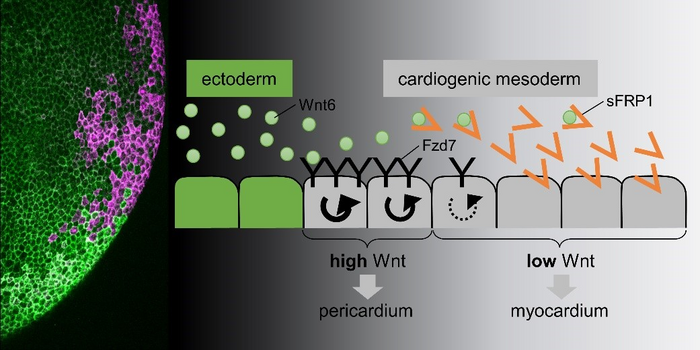Morphogens are molecules that travel from biological cell to cell to pattern tissues in the embryo. These molecules are important not only for the embryo during development, but also for the adult during tissue repair. However, the way these morphogens are distributed to ensure patterning occurs is still not fully understood.

Credit: Yamamoto et al., eLife 2022
Morphogens are molecules that travel from biological cell to cell to pattern tissues in the embryo. These molecules are important not only for the embryo during development, but also for the adult during tissue repair. However, the way these morphogens are distributed to ensure patterning occurs is still not fully understood.
Using a combination of experiments and mathematical modeling, a research team from the University of Tokyo and their international collaborators has learned more about the role morphogens play in tissue patterning. The results are relevant to medical applications, such as drug design. The team’s findings are published in the journal eLife.
The Wnt morphogen has emerged as a key regulator of heart development in vertebrates. These Wnt proteins are molecules that play an important role in cell development. However, it is still generally unclear to scientists exactly how Wnt regulates heart development. There are differences among the vertebrate classes, as well as redundancy in some species. However, scientists can study how Wnt regulates heart development in the Xenopus, an aquatic frog that is native to sub-Saharan Africa. The Xenopus, with its lungs and three-chamber heart, is cost-effective and useful to scientists in their study of human diseases.
In Xenopus heart development, scientists have already established that the Wnt6 morphogen is sent out by the epidermis, those outer layers of cells that make up the skin, to pattern the cardiogenic mesoderm, which is the group of cells in the embryo that will form the heart. From this patterning, a relatively thin pericardium (the membrane around the heart) and a broad myocardium (the heart’s muscular tissue) develop. Scientists are still working to better understand how the Wnt6 morphogen distribution is regulated to ensure reproducible positioning of the pericardium and myocardium in the cardiogenic mesoderm. “It is still unclear how reproducible patterning can be achieved with diffusing molecules, especially when that patterning concerns differentiation of thin tissues.” said Takayoshi Yamamoto, an assistant professor at the University of Tokyo and the first author and corresponding on the paper.
Scientists do know that in early embryo development, the range of Wnt8 morphogen signaling is precisely regulated heparan sulfate and secreted Wnt binding proteins, including Frzb (which is also known as sFRP3). Heparan sulfate is a carbohydrate that is important is embryo development. Wnt signaling is one of the main processes by which tissue takes shape during the development of the embryo. The research team wondered whether mechanisms similar to those that operate in early embryos also regulate distribution of Wnt6 morphogen in the cardiogenic mesoderm.
The Wnt receptor, Frizzled7, is essential for heart development. The expression of Frizzled7 is increased by Wnt signaling in the development of the nervous system in the Xenopus and in the development of human embryonic carcinoma cells, but there are no such reports in heart development. So the research team focused their study to analyze the way Wnt signaling occurs in the development of the heart, focusing on the extracellular components – the Frizzled7 cell-surface receptor, sFRP1 (an inhibitor of Wnt6 that can also travel from cell to cell) and heparan sulfate.
“With a combination of experiments and mathematical modeling, this receptor-feedback appears essential to shape a steep gradient of Wnt signaling. In addition, computer simulation revealed that this feedback imparts robustness against variations of Wnt ligand production and allows the system to reach a steady state quickly,” said Yamamoto.
Wnt6 and sFRP1 molecules not only regulate normal heart development in the embryo, but also regulate repair and regeneration after heart muscle injury, such as in the case of a myocardial infarction, or heart attack. “Our findings will be relevant to medical applications, for example, for drug design, since cell-surface molecules such as Frizzled or a specific modification of heparan sulfate or even the secreted molecule sFRP1, generally provide better drug targets than molecules inside cells. To reveal the precise regulation of morphogens and to consider medical applications, regulatory mechanisms of these components must be investigated further,” said Yamamoto.
The research was conducted in collaboration with researchers at the University of Aberdeen in the U.K.
###
Journal article
Takayoshi Yamamoto, Yuta Kambayashi, Yuta Otsuka, Boni Afouda, Claudiu Giuraniuc, Tatsuo Michiue, Stefan Hoppler, “Positive feedback regulation of frizzled-7 expression robustly shapes a steep Wnt gradient in Xenopus heart development, together with sFRP1 and heparan sulfate,” eLife: August 9, 2022, DOI: 10.7554/eLife.73818
Link: https://doi.org/10.7554/eLife.73818
Funding
Daiwa Anglo-Japanese Foundation with additional research support in Japan from MEXT/JSPS KAKENHI and in the United Kingdom from BHF and BBSRC
Related links
Graduate School of Arts and Sciences: https://www.c.u-tokyo.ac.jp/eng_site/
Research contact
Assistant Professor Takayoshi Yamamoto (Ph. D)
Department of Life Sciences, Graduate School of Arts and Sciences, The University of Tokyo
3-8-1 Komaba, Meguro-ku, Tokyo 153-8902, Japan
Email: [email protected]
About the University of Tokyo
The University of Tokyo is Japan’s leading university and one of the world’s top research universities. The vast research output of some 6,000 researchers is published in the world’s top journals across the arts and sciences. Our vibrant student body of around 15,000 undergraduate and 15,000 graduate students includes over 4,000 international students. Find out more at www.u-tokyo.ac.jp/en/ or follow us on Twitter at @UTokyo_News_en.
Journal
eLife
DOI
10.7554/eLife.73818
Article Title
Positive feedback regulation of frizzled-7 expression robustly shapes a steep Wnt gradient in Xenopus heart development, together with sFRP1 and heparan sulfate
Article Publication Date
9-Aug-2022




